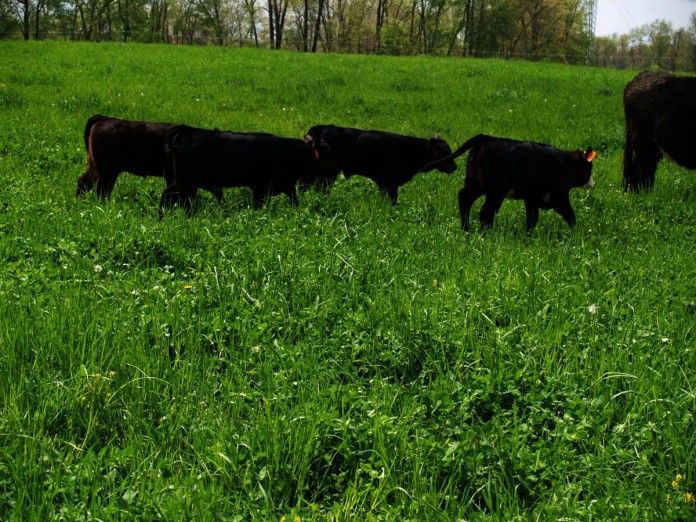SALEM, Ohio — The use of DNA testing to determine progeny traits and potential defects in beef cattle has come a long way in the past 20 years. Due to recent scientific advances, many in the industry feel the future of DNA testing is limitless.
“You get a tremendous amount of information to the point that it probably increases accuracy to at least 10 calves sired,” said Henry Bergfeld, owner of Pine Hill Farm in Summitville, Ohio.
“When a bull is only a few weeks old, you can have the information that it would have taken 10 calves to find out.”
Bergfeld was a member of the Ohio Angus Association when the group switched from blood typing to DNA testing for its parentage identification program in the 1990s. He said the science of DNA testing in beef cattle is limited only by the number of genetic markers scientists are able to identify.
“As we get more information, (genomic scientists) will be able to determine what markers control, for instance, muscle,” he said. “Then we can see how much muscle they will have and can increase progeny by using those bulls.”
Testing history
John Grimes, OSU Extension beef coordinator and owner of Maplecrest Farms in Hillsboro, Ohio, said the science of predicting progeny performance in beef cattle is far from new.
“We’ve always had some kind of blood testing to verify parentage,” Grimes said. “Years ago we just looked at them. Then we began recording weights, and in the late ’70s and ’80s, ultrasound allowed us to determine some carcass traits without harvesting them.”
Grimes, who raises Simmental and Angus, said these early scientific advancements led to the development of the American Angus Association’s expected progeny differences, or EPD, database.
Genetic testing is done in other breeds, Grimes said, but none have accumulated the amount of historical data as the Angus association.
The watershed moment in DNA testing came in 2008, Grimes said, when several previously unknown genetic defects in the Angus breed were discovered.
“That is when breeders started paying attention,” he said.
By 2010, genomic testing information was being added to standard EPDs, Grimes said.
“Through a blood test, immediately at birth, we can now determine, with much greater predictability, the top such-and-such of a breed,” he said. “It all adds more accuracy.”
How much value is placed on such genetic information, however, varies among cattlemen.
Cost of testing
According to the American Angus Association, basic genomic testing costs $75 per head. Grimes said a more economical genomic test that scores only marbling and gain is also available.
But while cost is perhaps the most common drawback to genetic testing, it is not the only one.
“It’s another tool we have in our toolbox, but because of who we market to, we just don’t have the demand for it,” said Pete Conkle, who calves around 50 commercial and registered Red Angus per year on Conkle Family Farms in Hanoverton, Ohio.
“We do a little embryonic transfer work, so we have to verify parentage for that, but our buyers are not requesting all this genomic information.”
Conkle did allow that there may be a time when more advanced genetic testing will make sense for his operation.
“If we would see the cattle market enter a downturn, we may need to market in some other areas,” he said. “You always want to get the most money you can for your calves and if (genomic testing) can add value, it is a positive.”
Who benefits
Grimes pointed to improved feed efficiency and profitability — determining how a pound of nutrition relates to a pound of gain — as an area where DNA testing has most recently been applied.
“That is something really hard to target in the real world,” he said. “So these are very real and practical applications. If I run a feedlot, and I can take a blood test early in life to determine which calves are going to Ruth’s Chris and which are going to McDonald’s, that saves me a lot of time and money.”
Bergfeld said both large, commercial operations and cattlemen with smaller herds are paying more attention to DNA testing, albeit for different reasons.
“If you have a large commercial operation, DNA testing can increase a carcass value by $200 to $250 per head,” he said. “And if you have a small herd and do a very good job with it, you can compete with the larger herds in a way that you never could before.”
He added that testing for genetic defects remains one of the most important applications of DNA testing.
“Back in the ’70s, before we had a test, we had to breed back 35 daughters and the geneticists still could not be 100 percent sure that (a bull) was proven clean of defects,” he said. “Now we can now determine within a few short months when there is a defect and which bulls are carrying.”
Related articles:
- Dairy graziers challenged to keep eye on genetics
- Ohio State Fair to require DNA submission and electronic identification
- Male chromosome hinders beef cattle reproduction
- DNA: An arriving tool for beef cattle











Nice article!
I would point out one issue. Compared with previous DNA testing, with genomic prediction and genomic-enhanced EPDs we are no longer concerned with “genetic markers scientists are able to identify.” With genomic-enhanced EPDs we take the entire DNA of an animal, all 20,000 genes, into account in the genomic predictions. See http://steakgenomics.blogspot.com/2012/08/gene-tests-vs-genomic-selection.html and related posts for more information.
The limiting factor is no longer identifying markers. The limiting factor is the number of animals with trait records and genotypes.